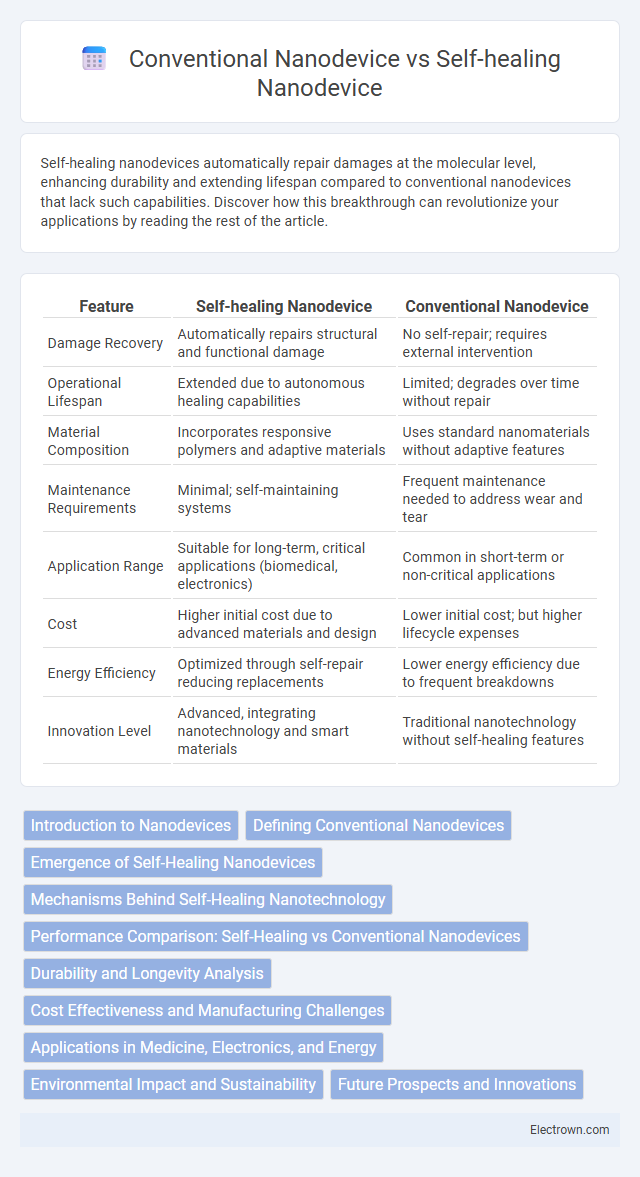Self-healing nanodevices automatically repair damages at the molecular level, enhancing durability and extending lifespan compared to conventional nanodevices that lack such capabilities. Discover how this breakthrough can revolutionize your applications by reading the rest of the article.
Table of Comparison
| Feature | Self-healing Nanodevice | Conventional Nanodevice |
|---|---|---|
| Damage Recovery | Automatically repairs structural and functional damage | No self-repair; requires external intervention |
| Operational Lifespan | Extended due to autonomous healing capabilities | Limited; degrades over time without repair |
| Material Composition | Incorporates responsive polymers and adaptive materials | Uses standard nanomaterials without adaptive features |
| Maintenance Requirements | Minimal; self-maintaining systems | Frequent maintenance needed to address wear and tear |
| Application Range | Suitable for long-term, critical applications (biomedical, electronics) | Common in short-term or non-critical applications |
| Cost | Higher initial cost due to advanced materials and design | Lower initial cost; but higher lifecycle expenses |
| Energy Efficiency | Optimized through self-repair reducing replacements | Lower energy efficiency due to frequent breakdowns |
| Innovation Level | Advanced, integrating nanotechnology and smart materials | Traditional nanotechnology without self-healing features |
Introduction to Nanodevices
Nanodevices, engineered at the atomic or molecular scale, enable precise manipulation and control in fields like medicine, electronics, and materials science. Conventional nanodevices often face challenges such as degradation and failure under stress, limiting their long-term functionality. Self-healing nanodevices incorporate materials and mechanisms that autonomously repair damages, extending device lifespan and enhancing reliability in critical applications.
Defining Conventional Nanodevices
Conventional nanodevices are engineered at the nanoscale to perform specific functions, utilizing fixed materials and structures without the ability to repair themselves after damage. These devices rely on external maintenance or replacement when faults occur, limiting their durability and operational lifespan. Understanding the limitations of conventional nanodevices helps highlight the advantages self-healing nanodevices offer to enhance performance and reliability.
Emergence of Self-Healing Nanodevices
Self-healing nanodevices represent a breakthrough in nanotechnology by integrating responsive materials capable of autonomously repairing damage at the nanoscale, extending device lifespan and reliability beyond conventional nanodevices. These devices leverage stimuli-responsive polymers, nanozymes, and dynamic covalent bonds to restore structural integrity without external intervention, overcoming limitations of static, non-adaptive conventional nanodevices. The emergence of self-healing mechanisms promises enhanced durability for applications in flexible electronics, biomedical implants, and environmental sensors where conventional nanodevices are prone to failure under mechanical stress or environmental degradation.
Mechanisms Behind Self-Healing Nanotechnology
Self-healing nanodevices utilize advanced materials capable of autonomously repairing damage at the nanoscale through mechanisms like dynamic covalent bonding, microvascular networks, or embedded healing agents that activate upon detecting structural flaws. Conventional nanodevices, in contrast, lack these intrinsic repair capabilities and require external intervention or replacement when damaged. Your choice of nanodevice technology directly impacts durability and maintenance costs, with self-healing options offering longer operational lifespans through innovative molecular or nanoscale recovery processes.
Performance Comparison: Self-Healing vs Conventional Nanodevices
Self-healing nanodevices exhibit significantly enhanced reliability and longevity compared to conventional nanodevices, owing to their intrinsic ability to autonomously detect and repair structural defects at the nanoscale. Performance metrics such as operational lifespan, response time, and fault tolerance demonstrate measurable improvements, with self-healing nanodevices maintaining functional integrity under harsh environmental conditions that typically degrade conventional counterparts. This adaptive capability reduces maintenance frequency and increases efficiency, making self-healing nanodevices superior for applications requiring sustained nanoscale performance.
Durability and Longevity Analysis
Self-healing nanodevices exhibit significantly enhanced durability and longevity compared to conventional nanodevices due to their ability to autonomously detect and repair structural damages at the nanoscale, preventing performance degradation. Conventional nanodevices often suffer from wear and material fatigue, leading to reduced operational lifespan and increased maintenance requirements. The integration of self-healing polymers and nanocomposites in these devices ensures sustained functionality under harsh conditions, making them ideal for long-term applications in biomedical, electronic, and energy storage fields.
Cost Effectiveness and Manufacturing Challenges
Self-healing nanodevices offer long-term cost savings by reducing maintenance and replacement needs compared to conventional nanodevices, which often require frequent repairs due to wear and damage. Manufacturing challenges for self-healing nanodevices include complex material synthesis and integration of dynamic repair mechanisms that increase initial production costs and technical hurdles. Conventional nanodevices benefit from established manufacturing processes, resulting in lower upfront costs but higher lifecycle expenses related to device failure and downtime.
Applications in Medicine, Electronics, and Energy
Self-healing nanodevices enhance durability and functionality in medicine by enabling targeted drug delivery and real-time tissue repair, surpassing conventional nanodevices that lack autonomous repair capabilities. In electronics, self-healing nanodevices improve the lifespan and reliability of flexible circuits and sensors, addressing issues like mechanical fatigue and micro-cracks that conventional nanodevices cannot autonomously fix. Energy applications benefit from self-healing nanodevices through more efficient and longer-lasting solar cells and batteries, as these devices can recover from physical or chemical damage, unlike traditional nanodevices that degrade over time without self-repair mechanisms.
Environmental Impact and Sustainability
Self-healing nanodevices significantly reduce electronic waste by autonomously repairing damages, extending device lifespans and lowering the demand for raw materials compared to conventional nanodevices requiring frequent replacement. These advanced materials enhance sustainability through decreased resource extraction and minimized landfill contributions, addressing environmental concerns linked to nanoparticle pollution and heavy metal contamination. Their integration in green technologies promotes eco-friendly innovation, positioning self-healing nanodevices as crucial for sustainable nanotechnology development.
Future Prospects and Innovations
Self-healing nanodevices offer significant advancements over conventional nanodevices by enabling autonomous repair mechanisms that extend device longevity and reduce maintenance costs. Innovations in materials science and nanotechnology are driving the development of responsive nanostructures capable of detecting and repairing damage at the molecular level, promising enhanced reliability in medical, environmental, and industrial applications. Future prospects include integration with smart systems and AI for adaptive functionality, transforming nanodevices into dynamic tools for real-time problem solving and sustainability improvements.
Self-healing Nanodevice vs Conventional Nanodevice Infographic

 electrown.com
electrown.com